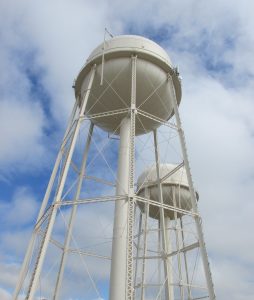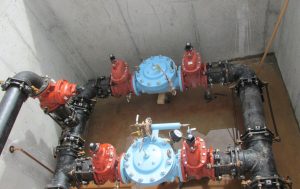Projects
Tinker Air Force Base Case Study
Altitude and Check Valves Play Integral Part in Air Force Base Fire Protection
Reliable water levels are a necessity when it comes to water towers – especially when water towers are relied upon for fire protection.
Five water towers are situated on the Tinker Air Force base complex just outside of Oklahoma City. Tinker is the headquarters of the Air Force Materiel Command’s (AFMC) Oklahoma City Air Logistics Center (OC-ALC), which is the worldwide manager for a wide range of aircraft, engines, missiles, software and avionics and accessories components.
When the Tinker Air Force Base water towers, which are mainly used for fire pumps and water supply, began having problems keeping up their water levels, Tinker officials knew they needed to take preventive action.
Under normal operating conditions, valves within the water towers are expected to turn on and open if the water pressure in the tower falls below 52 psi. For normal operations, it is important for the water levels to be maintained at the same pressure throughout the base. When Tinker’s water towers began having issues maintaining consistent water levels, air force base officials decided to replace the altitude valves on the five towers.
Air Force Base Initiates Valve Replacement Program
Armed with specs from the U.S. Army Corps of Engineers, a team of base engineers conducted a search to find a valve manufacturer that fit the project requirements. OCV Control Valves, a company with over 60 years of experience in the design, manufacturing and application of control valves, was selected for the project.
OCV was commissioned to replace both the altitude control and check valves on all five water towers on the base. The project involved replacing not only valves but also the valve vaults. Each vault had to be dug out of the ground and replaced with new piping and valves.
OCV determined that a delayed drawdown altitude valve was needed to empty the water towers before they would be refilled by OCV valves. The OCV team reviewed drawings and worked through the application with the base engineers and concluded that it would be more effective to not completely drain the tanks as they would not have any pressure to fight fires if the tank level was low.
One of the first steps of the project involved the manufacturing of the valves. “Lead times for these types of valves can be upwards of six months,” said Mike Walker, project manager at Trade Mechanical, a year-round subcontractor to Tinker Air Force Base. “However, OCV was able to deliver the products well ahead of that time frame, allowing the project to stay on schedule.”
According to Walker, OCV answered project questions and assisted with issues in a timely manner. When one of the valves didn’t immediately set or regulate, OCV engineers stayed on site until the problem was solved. OCV was able to verify the valves were set according to the specs that were submitted. The contractor was able to set the valve correctly thanks to OCV’s aid to thoroughly and successfully complete the job.
Richard Marsh, President of Trade Mechanical Contractors, also added, “OCV was instrumental in providing on-site technical and engineering support for the start-up of the valves. Any issues that came up during start-up period were addressed and resolved immediately.”
Towards the end of the project, OCV Control Valves was also on hand for the commissioning. Once each of the valves were deemed to be working properly and the pressure was correctly set, commissioning occurred. The U.S. Army Corps of Engineers, base engineers and base contractors were all involved in the commissioning. There were some minor adjustments that occurred that OCV was able to assist with.
“OCV Control Valves delivered the products on time, made them perform as proposed and helped answer our questions,” said Walker. “There was good teamwork all around.”
“We appreciate the prompt responses and the outstanding customer service that the OCV team consistently provides!”
Harry Kitzmann
WSN Construction
“Our customer was in a shutdown and needed a 2.5” valve immediately. OCV stepped up and was able to build the 2.5” valve in one day and ship it next day air to the customer. Fantastic work!!”
Suzie Sommer
Conbraco Industries
“We pride ourselves on creating innovative solutions and providing quality products to our clients in the fastest possible time frame. Sometimes that means seeking out and switching to a better manufacturer. Patty Space’s knowledge and response time won me over! And, OCV delivered in less than 5 weeks – something the competition could not do!”
Paul Samlalsingh
Online Valves, Inc.
“OCV and Jim Gibson are the #1 supplier of control valves in our circle of vendors. Their integrity is never compromised as they strive for Complete Customer Satisfaction. Their word is their bond and they live by it. Their intimate knowledge of their products and our industry is unsurpassed and we look forward to many years of a mutually successful relationship as we continue to grow together and discover new markets.”
Bruce Callahan
Grey Wolf Services, LLC
“Since 1996 Dakota Pump & Control has partnered with OCV. DPC takes who we represent on our line card very seriously, and we couldn’t be happier with this partnership. OCV has a catalog that covers all our needs, as well as the support a service based company like ours demands. We look forward to whatever valve challenges are presented to us, because we have the right manufacturer that can support us every step of the way.”
Darin Waldner
Dakota Pump & Control
“The Otoe-Missouria Tribe of Oklahoma has been doing business with OCV since 1993. We have utilized them for all types of valves, as well as parts. OCV always has the answers. Working with Robert and Jarrod has been a pleasure!”
Jonathan Haley
Otoe-Missouria Tribe of Oklahoma
“A lot of companies preach customer service, but their actions don’t reflect it. That’s not the case when it comes to OCV. I have met many associates at OCV, from Plant to Sales to Engineering – all are focused on taking care of their customers. OCV is expedient in quoting projects and has even been known to troubleshoot valves from other manufacturers and construct valves in an emergency to get a city out of a jam. OCV practices what they preach!”
Richard Jones
Specified Utility Associates
“D&W has maintained a relationship with OCV as a Rep for 30+ years. Although this industry, and even products, have gone through major transformations over that time, OCV’s dedication to customer service has remained steadfast. From a friendly voice when you call their office, to the expert advice you receive when troubleshooting a problem – OCV sets the standard and no one else comes close.”
Andy Brown
D&W Systems
“We represent several prominent manufacturers, but OCV distinguishes themselves with their customer focused approach. It seems as if every valve they fabricate is going to their neighbor. Their quality and workmanship is second-to-none and when you call for support, you feel like family.”
Tim Rice
Municipal Treatment Equipment
“I love representing OCV and working with their knowledgeable staff! Whether I need help with pricing, or addressing engineer comments, or following up on shipments – OCV always responds promptly and efficiently. Their level of customer service is top notch! I’ve had the pleasure of working with OCV for over 12 years now, and I’ve never had a warranty request from any of our customers – which says a lot about the high quality of their products.”
Sandra Reser
Mellen & Associates, Inc.
“As an inside salesman for a pump company located in Southern Illinois, I am always looking for various pumping related parts and materials. Jim Gibson and the fine folks at OCV Fluid Solutions were ready to meet my needs. The service is great and the price is even better!”
Ron Krammler
C and C Pumps & Supply
“OCV was instrumental in providing on-site technical and engineering support for the start-up of the valves.”
Richard Marsh
Trade Mechanical Contractors
“OCV Control Valves delivered the products on time, made them perform as proposed and helped answer our questions. There was good teamwork all around.”
Mike Walker
Trade Mechanical Contractors
“Personally having 18 years of verifiable field experience, OCV is very easy to work with. They have knowledgeable tech support, their sales team is exceptional, and there have been no hiccups with lead times. Everyone I talk to at OCV knows the valves and know the equipment they are selling.”
Steven Olenicki
3rd Coast Pump & Equipment
“OCV was very helpful. Not only did they always answer our questions and make sure the valves were exactly what we needed. but they were also able to provide us with two new pre-set valves in about three to four weeks.”




